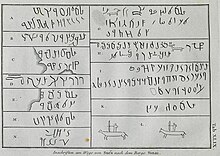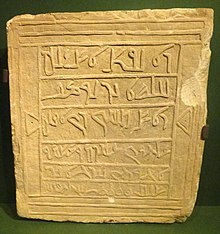| Nabataean script | |
|---|---|
| Script type | |
Time period | 2nd century BC to 4th century AD |
| Direction | Right-to-left script |
| Languages | Nabataean Aramaic Nabataean Arabic |
| Related scripts | |
Parent systems | |
Child systems | Arabic script |
| ISO 15924 | |
| ISO 15924 | Nbat (159), Nabataean |
| Unicode | |
Unicode alias | Nabataean |
| U+10880–U+108AF Final Accepted Script Proposal | |

The Nabataean script is an abjad (consonantal alphabet) that was used to write Nabataean Aramaic and Nabataean Arabic from the second century BC onwards.[2][3] Important inscriptions are found in Petra (now in Jordan), the Sinai Peninsula (now part of Egypt), and other archaeological sites including Abdah (in Israel) and Mada'in Saleh in Saudi Arabia.
Nabataean is only known through inscriptions and, more recently, a small number of papyri.[4] It was first deciphered in 1840 by Eduard Friedrich Ferdinand Beer.[4] 6,000 – 7,000 Nabataean inscriptions have been published, of which more than 95% are extremely short inscriptions or graffiti, and the vast majority are undated, post-Nabataean or from outside the core Nabataean territory.[4] A majority of inscriptions considered Nabataean were found in Sinai,[4] and another 4,000 – 7,000 such Sinaitic inscriptions remain unpublished.[5] Prior to the publication of Nabataean papyri, the only substantial corpus of detailed Nabataean text were the 38 funerary inscriptions from Hegra (Mada'in Salih), published by Julius Euting in 1885.[4]


The alphabet is descended from the Aramaic alphabet. In turn, a cursive form of Nabataean developed into the Arabic alphabet from the 4th century,[3] which is why Nabataean's letterforms are intermediate between the more northerly Semitic scripts (such as the Aramaic-derived Hebrew) and those of Arabic.

As compared to other Aramaic-derived scripts, Nabataean developed more loops and ligatures, likely to increase speed of writing. The ligatures seem to have not been standardized and varied across places and time. There were no spaces between words. Numerals in Nabataean script were built from characters of 1, 2, 3, 4, 5, 10, 20, and 100.
| Name | Phoenician | Phoneme | Aramaic | Nabataean | Syriac | Arabic | Phoneme |
|---|---|---|---|---|---|---|---|
| ʾālep | 𐤀 | ʾ [ʔ] | 𐡀 | ܐ | ﺍ, ء | ʾ [ʔ] | |
| bēt | 𐤁 | b [b] | 𐡁 | ܒ | ﺏ | b [b] | |
| tāw | 𐤕 | t [t] | 𐡕 | ܬ | ت | t [t] | |
| ث | ṯ [θ] | ||||||
| gīml | 𐤂 | g [ɡ] | 𐡂 | ܓ | ﺝ | j [d͡ʒ] | |
| ḥēt | 𐤇 | ḥ [ħ] | 𐡇 | ܚ | ح | ḥ [ħ] | |
| خ | ḵ [x] | ||||||
| dālet | 𐤃 | d [d] | 𐡃 | ܕ | د | d [d] | |
| ذ | ḏ [ð] | ||||||
| rēs, reš | 𐤓 | r [r] | 𐡓 | ܪ | ﺭ | r [r] | |
| zayin | 𐤆 | z [z] | 𐡆 | ܙ | ﺯ | z [z] | |
| śāmek | 𐤎 | ś [s] | 𐡎 | ܣ | – | – | |
| šīn | 𐤔 | š [ʃ] | 𐡔 | ܫ | س, ش | s [s], š [ʃ] | |
| ṣādē | 𐤑 | ṣ [sˤ] | 𐡑 | ܨ | ص | ṣ [sˤ] | |
| ض | ḍ [dˤ] | ||||||
| ṭēt | 𐤈 | ṭ [tˤ] | 𐡈 | ܛ | ط | ṭ [tˤ] | |
| ظ | ẓ [ðˤ] | ||||||
| ʿayin | 𐤏 | ʿ [ʕ] | 𐡏 | ܥ | ع | ʿ [ʕ] | |
| غ | ḡ [ɣ] | ||||||
| pē | 𐤐 | p [p] | 𐡐 | ܦ | ف | f [f] | |
| qōp | 𐤒 | q [q] | 𐡒 | ܩ | ﻕ | q [q] | |
| kāp | 𐤊 | k [k] | 𐡊 | ܟ | ﻙ | k [k] | |
| lāmed | 𐤋 | l [l] | 𐡋 | ܠ | ﻝ | l [l] | |
| mēm | 𐤌 | m [m] | 𐡌 | ܡ | ﻡ | m [m] | |
| nūn | 𐤍 | n [n] | 𐡍 | ܢ | ﻥ | n [n] | |
| he | 𐤄 | h [h] | 𐡄 | ܗ | ه | h [h] | |
| wāw | 𐤅 | w [w] | 𐡅 | ܘ | ﻭ | w [w] | |
| yod | 𐤉 | y [j] | 𐡉 | ܝ | ي | y [j] |
((cite book)): CS1 maint: location missing publisher (link)|
See also: Nabataean (Unicode block) |
The Nabataean alphabet (U+10880–U+108AF) was added to the Unicode Standard in June 2014 with the release of version 7.0.
| Nabataean[1][2] Official Unicode Consortium code chart (PDF) | ||||||||||||||||
| 0 | 1 | 2 | 3 | 4 | 5 | 6 | 7 | 8 | 9 | A | B | C | D | E | F | |
| U+1088x | 𐢀 | 𐢁 | 𐢂 | 𐢃 | 𐢄 | 𐢅 | 𐢆 | 𐢇 | 𐢈 | 𐢉 | 𐢊 | 𐢋 | 𐢌 | 𐢍 | 𐢎 | 𐢏 |
| U+1089x | 𐢐 | 𐢑 | 𐢒 | 𐢓 | 𐢔 | 𐢕 | 𐢖 | 𐢗 | 𐢘 | 𐢙 | 𐢚 | 𐢛 | 𐢜 | 𐢝 | 𐢞 | |
| U+108Ax | 𐢧 | 𐢨 | 𐢩 | 𐢪 | 𐢫 | 𐢬 | 𐢭 | 𐢮 | 𐢯 | |||||||
| Notes | ||||||||||||||||